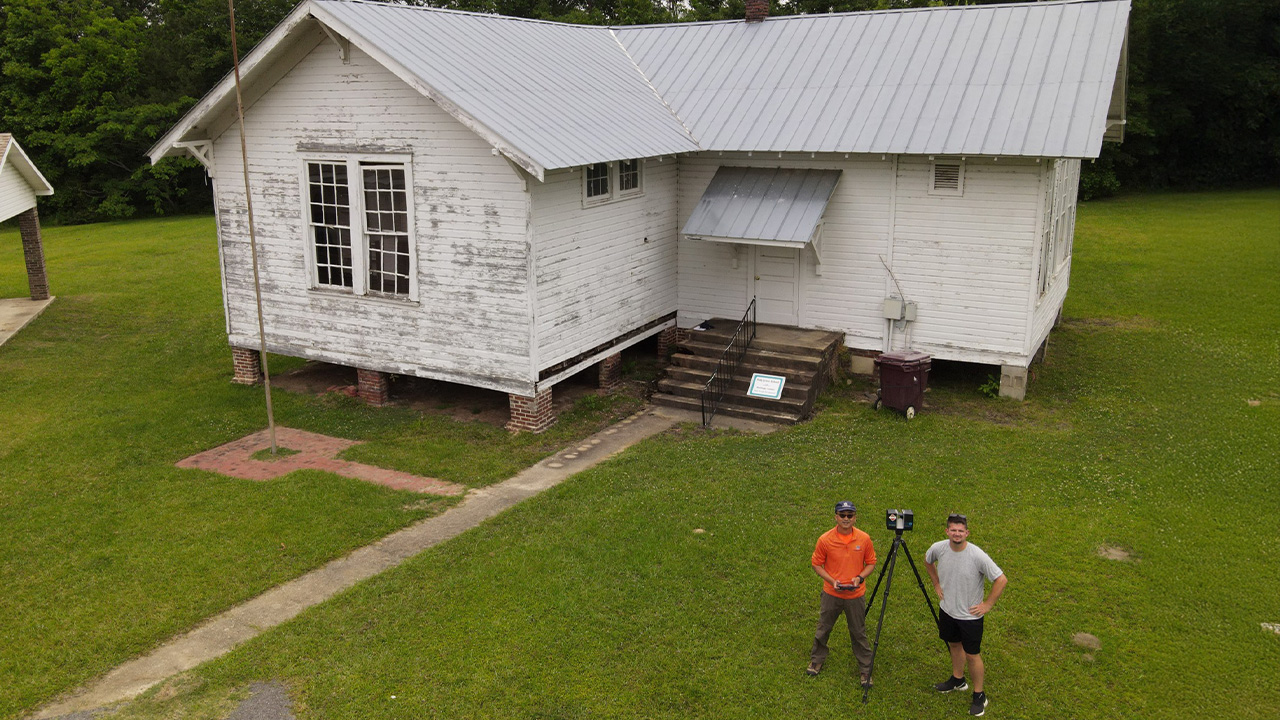content body

CADC faculty members Junshan Liu, left, and Gorham Bird are part of a team researching the history and preservation of the Rosenwald Schools in Alabama, including the Tankersley School in Hope Hull, Alabama.
Faculty members in Auburn University’s College of Architecture, Design and Construction (CADC) come from a wide variety of backgrounds. In addition to being teachers, they are designers, architects, construction managers, artists and engineers.
The CADC’s faculty members have a well-established reputation as world-class educators, but over the past 15 years, they have also made remarkable progress toward building a vibrant and robust portfolio of impactful scholarship and research. A big part of this success has been the college’s investments in support infrastructure for faculty looking to increase their research activities.
These investments have paid off in major ways: In 2018, 14 faculty members were engaged in developing extramural grant proposals; by 2023, that number had more than doubled to 30. Also in 2018, CADC submitted proposals for $1.4 million in grants; by 2023, that number was $12.7 million, almost tenfold growth in five years. Grant awards have mirrored the growth in proposals, with a 500% increase since 2018.
So, what’s driving this rapid increase in research activity and funding? In large part, it’s the work of the CADC Research Office, which reaches across disciplines to faculty of all levels.
Intramural grant programs
CADC offers three different intramural grant opportunities; the CADC Seed Grants, the McWhorter Fund for Excellence and the Center for Construction Innovation and Collaboration. These small grants, ranging from $5,000 to $20,000, are a great way for junior faculty to gain experience developing research initiatives and building a track record of responsibly managing grant funds.
“A lot of our faculty are used to putting together proposals for professional work,” said David Hinson, CADC’s associate dean for research. “But that’s really different from the way you talk about projects and proposals in a grant or contract. Our faculty have a wealth of experience in practice and in teaching; we’re just helping them present their work in the best way and navigate what these different systems look like.”
The CADC Research Office team meets with faculty to talk through research agendas, funding opportunities and promoting their work. Once a grant is awarded, they help them to manage funds and track spending.
Connecting with resources on campus
In addition to identifying intramural funding, the research staff helps to connect CADC faculty members with faculty and staff from other units on campus, as well as the many intramural funding opportunities at Auburn.
One great campus resource is the AU IP Exchange (IPX) Office, which supports innovation and helps Auburn faculty bring new ideas and products to the market with the help of external partners. This is especially useful for industrial design and building science faculty members who want to pursue a patent for products they’ve created.
Zack Kohrman is a lecturer in industrial design who has worked with the IPX Office several times, both as a student and a faculty member at Auburn. During the COVID-19 pandemic, he and his father, a physician, applied for a patent for a respirator design they created. Their patent was finally issued this past summer, and they are currently simplifying their design in preparation for production.
“There’s a whole slew of reasons the IPX Office is unique and beneficial to the university,” Kohrman said. “The standard royalty rate we have really is an incentive for faculty and staff to pursue research and inventions; the staff are professional, well-versed and take the time to fully understand what your new invention is to give inventors the best shot at the intellectual property going through. This is great for newcomers to intellectual property and commercialization and excellent for us old hands who want to move fast and efficiently.”
Workshops and lectures
Back in the college, the CADC Research Office hosts a wide variety of workshops on scholarly program design, grant proposal development, outreach scholarship, artificial intelligence (AI) and book proposal development.
“We usually have three to four workshops per semester, and then we’re sharing all of those recordings with faculty, along with other resources like the tenure and promotion guidelines and sample proposals,” said Jessica Holmes, CADC’s research manager.
Some workshops target new and junior faculty, introducing the research staff and the intramural funding opportunities, while others that focus on commercialization and IP attract a more experienced crowd. Last spring’s workshop on writing a book was attended by a broad cross section of both junior and senior faculty across disciplines.
Growing from a Seed to a National Park (grant)
Holmes says Assistant Professor Gorham Bird is a great example of how the college’s resources can help faculty rapidly grow their funding, work and partnerships. Bird, a CADC alumnus and practicing architect, began his research endeavors with a $5,000 CADC Seed Grant. Holmes connected him with building science Professor Junshan Liu and other faculty across campus, and he quickly became an integral part of a team studying the history and preservation of the remaining Rosenwald Schools in Alabama.
Along with the team, Bird began to apply for larger grants from external funders, and they eventually landed a National Park Service grant for nearly $500,000. His research has attracted media coverage, including an interview about his work on Troy Public Radio, and he says the Research Office has been instrumental in his team’s success.
“The staff’s support pre-award and post-award allows research teams to focus on the work at hand, without getting overwhelmed with the administrative requirements of many grants,” Bird said. “Their knowledge of contractual requirements, coordination, reporting and budget management cannot be understated. I consider our research staff an integral part of our team, so we include them in major meetings with external funders and community organizations we interface with so they can also experience the most fulfilling aspects of our work.”





